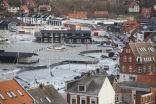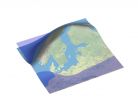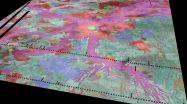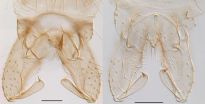INFORMATION:
Article in Climate Research: http://www.int-res.com/abstracts/cr/v64/n1/p15-23/
Contact:
Aslak Grinsted, Associate Professor, Centre for Ice and Climate, Niels Bohr Institute, University of Copenhagen, +45 3138-0716, aslak@nbi.ku.dk
Risk of major sea level rise in Northern Europe
2015-06-18
(Press-News.org) Global warming leads to the ice sheets on land melting and flowing into the sea, which consequently rises. New calculations by researchers from the Niels Bohr Institute show that the sea level in Northern Europe may rise more than previously thought. There is a significant risk that the seas around Scandinavia, England, the Netherlands and northern Germany will rise by up to about 1½ meters in this century. The results are published in a special issue of the scientific journal Climate Research.
Sea level rise is a significant threat to the world's coastal areas, but the threat is not the same everywhere on Earth - it depends on many regional factors.
"Even though the oceans are rising, they do not rise evenly across the globe. This is partly due to regional changes in the gravitational field and land uplift," explains Aslak Grinsted, associate professor at the Centre for Ice and Climate at the Niels Bohr Institute, University of Copenhagen.
Sea distributed unevenly
He explains that gravity over the surface of the land and sea varies due to differences in the subsurface and surroundings - the greater the mass, the greater the gravity. The enormous ice sheet on Greenland attracts the sea, which consequently becomes higher around Greenland. When the ice sheet melts and flows out to sea as water, this attraction is reduced and even though more water has entered the sea, the sea level around Greenland would fall.
Another very important effect for Northern Europe is that during the ice age we had a thick ice sheet that weighted down the land. When the weight disappears, then the land rises and even though it has been more than 10,000 years since the ice disappeared, the land is still rising. The calculations show that in the Gulf of Bothnia the land is still rising faster than the expected sea level rise.
The UN Intergovernmental Panel on Climate Change (IPCC) has estimated that the average global warming in this century will rise by 4°C in a business-as-usual scenario. That is to say, if we continue to emit greenhouse gases as we have up to now. The effect will be a rise in sea levels.
"Based on the UN climate panel's report on sea level rise, supplemented with an expert elicitation about the melting of the ice sheets, for example,how fast the ice on Greenland and Antarctica will melt while considering the regional changes in the gravitational field and land uplift, we have calculated how much the sea will rise in Northern Europe," explains Aslak Grinsted.
Higher increase than expected
The calculations show that there is a real risk that what have been regarded as high scenarios in the Netherlands and England will be surpassed.
"For London, the calculated best estimate is that sea level will rise by 0.8 meters. In England, a sea level rise of more than 0.9 meters in this century has been considered highly unlikely, but our new calculation shows that there is a 27% chance that this limit is surpassed and we can not exclude a sea level rise of up to 1.75 meters this century," explains Aslak Grinsted.
For the Netherlands, the best estimate of sea level rise is 0.83 meters, but the calculations show that there is a 26% chance that it will exceed the existing high-end scenario of 1.05 meters and a sea level rise of up to 1.80 meters cannot be excluded.
"Both countries have already established protections for the coasts with barriers, sluice gates, and dikes, but is it enough? I hope that our calculations for worst-case-scenarios will be taken into consideration as the countries prepare for climate change," says Aslak Grinsted.
Copenhagen is slightly less exposed. Here the best estimate is that sea levels will rise by 0.68 meters, but there is a risk of increases up to 1.6 meters.
But even though the sea level around the world will rise by an average of 80 cm, the sea level in the Gulf of Bothnia in Finland is expected to fall by 10 cm due to land uplift. The land is rising faster than the sea is rising.
The reduced gravitational attraction of the Greenland ice sheet will result in lower sea levels as far away as 2000 km from Greenland in Ireland, Scotland and Norway. This means that the melting from Greenland will contribute 14 cm to the global sea level, but locally in Edinburgh it will result in a fall of 4 cm.
Aslak Grinsted explains that the great uncertainty in relation to future global sea level rise is how quickly the ice on Antarctica will melt and whether it will happen in a large collapse. But even without a collapse of the ice on Antarctica, vulnerable countries should prepare contingency plans in their coastal defence for the 'worst-case-scenario'.
ELSE PRESS RELEASES FROM THIS DATE:
Magnetic field discovery gives clues to galaxy-formation processes
2015-06-18
Astronomers making a detailed, multi-telescope study of a nearby galaxy have discovered a magnetic field coiled around the galaxy's main spiral arm. The discovery, they said, helps explain how galactic spiral arms are formed. The same study also shows how gas can be funneled inward toward the galaxy's center, which possibly hosts a black hole.
'This study helps resolve some major questions about how galaxies form and evolve,' said Rainer Beck, of the Max-Planck Institute for Radio Astronomy (MPIfR), in Bonn, Germany.
The scientists studied a galaxy called IC 342, some ...
Massively parallel gene function assays aim to reduce uncertainty of genetic diagnoses
2015-06-18
Patients seeking certainty in genetic tests often receive a perplexing result. Many learn they carry a 'variant of unknown significance' of a disease-linked gene. Such variants might -- or equally might not -- increase disease risk.
A study published in the June issue of the journal Genetics characterized nearly 2000 variants of the breast cancer-associated gene BRCA1, demonstrating the potential of a new approach for sorting out which variants are harmful and which are harmless.
Because genetic tests increasingly use more comprehensive multi-gene and whole-genome sequencing ...
Origins of the Hawaiian hoary bat revealed by GVSU professor and research team
2015-06-18
ALLENDALE, Mich. -- A Grand Valley State University biology professor and her team of scientists have determined new information about an endangered species in the U.S., which could impact its protection under the Endangered Species Act.
The study, "Two Tickets to Paradise: Multiple Dispersal Events in the Founding of Hoary Bat Populations in Hawai'i," was recently published in PLOS ONE at http://journals.plos.org/plosone/article?id=10.1371/journal.pone.0127912.
The study, led by Amy Russell, associate professor of biology at Grand Valley, reveals that the Hawaiian ...
Temple-led team uses stem cell exosomes to induce damaged mouse hearts to self-repair
2015-06-18
(Philadelphia, PA) - A little more than a decade ago, researchers discovered that all cells secrete tiny communications modules jammed with an entire work crew of messages for other cells. Today, a team of researchers, led by stem cell researcher Raj Kishore, PhD, Director of the Stem Cell Therapy Program at the Center for Translational Medicine at Temple University School of Medicine (TUSM), is harnessing the communications vesicles excreted by stem cells and using them to induce the damaged heart to repair itself. Their research is the June 19 cover story in the leading ...
Study suggests active volcanism on Venus
2015-06-18
PROVIDENCE, R.I. [Brown University] -- An international team of scientists has found some of the best evidence yet that Venus, Earth's nearest neighbor, is volcanically active.
In combing through data from the European Space Agency's Venus Express mission, the scientists found transient spikes in temperature at several spots on the planet's surface. The hotspots, which were found to flash and fade over the course of just a few days, appear to be generated by active flows of lava on the surface.
"We were able to show strong evidence that Venus is volcanically, and thus ...
Researchers find a potential target for the treatment of type 2 diabetes
2015-06-18
Currently, there are more than 350 million type 2 diabetics and according to the World Health Organization (WHO) by 2030 it will be the 7th leading cause of death worldwide.
The hallmark of type 2 diabetes is insulin resistance, which is initially compensated for by an increase in beta cell size (responsible for producing insulin). However, the beta cells of such patients will eventually collapse and die, leading to full blown type 2 diabetes.
Researchers from the Laboratory of Cancer Metabolism at IDIBELL, led by Sara Kozma, have shown in animal models that inhibition ...
Best practices highlighted to prevent infections during healthcare laundry process
2015-06-18
NEW YORK (June 18, 2015) - Proper laundering and handling are important in achieving and maintaining the hygienically-clean quality of healthcare fabrics and textiles delivered to the point of care, according to a new review that highlights evidence-based strategies to inhibit potentially serious contamination. The review, based on findings and recommendations from peer-reviewed studies, as well as current standards and guidelines, is published online in Infection Control & Hospital Epidemiology, the journal of the Society for Healthcare Epidemiology of America (SHEA). ...
New model to study HIV latency in brain cells
2015-06-18
Over 35 million people worldwide are currently infected by HIV. Antiviral therapies can keep the virus from multiplying. However, no drug can cure infection so far, because various cell types continue to carry the virus in a latent, i.e. quiescent, state. Scientists of Helmholtz Zentrum Muenchen have now established a model for latent HIV infection of brain cells. The researchers used this model to identify various compounds that affect latency of the virus in the brain. This study was published in the journal AIDS.
"Chronic infection is caused by long-lived cells with ...
Unknown midge mystery solved
2015-06-18
Revisiting original types and DNA analysis exposed hidden diversity in minute non-biting midges. Two species new to science were discovered and one misapprehended species was removed by following the traces back to the source in Brussels. The study was published in the open access journal ZooKeys.
"Nobody suspected a mystery until we solved it", says Elisabeth Stur, the senior author of the paper describing the misconception. - "Maybe even some will be upset that we discovered this long lasting misidentification".
It all started with Elisabeth Stur and Torbjørn ...
'Genomics holds key to understanding ecological and evolutionary processes'
2015-06-18
Scientists at the University of Southampton think that Next-Generation Sequencing (NGS) of invasive organisms holds the key to furthering our understanding of ecological and evolutionary processes.
In a review of recent studies published in Current Zoology, the researchers say the technique is underutilised in the field of invasion biology. They believe NGS has the potential to transform our understanding of why non-native species adapt and thrive in new environments, often at the expense of their indigenous competitors.
The key to the success of biological invasions ...




